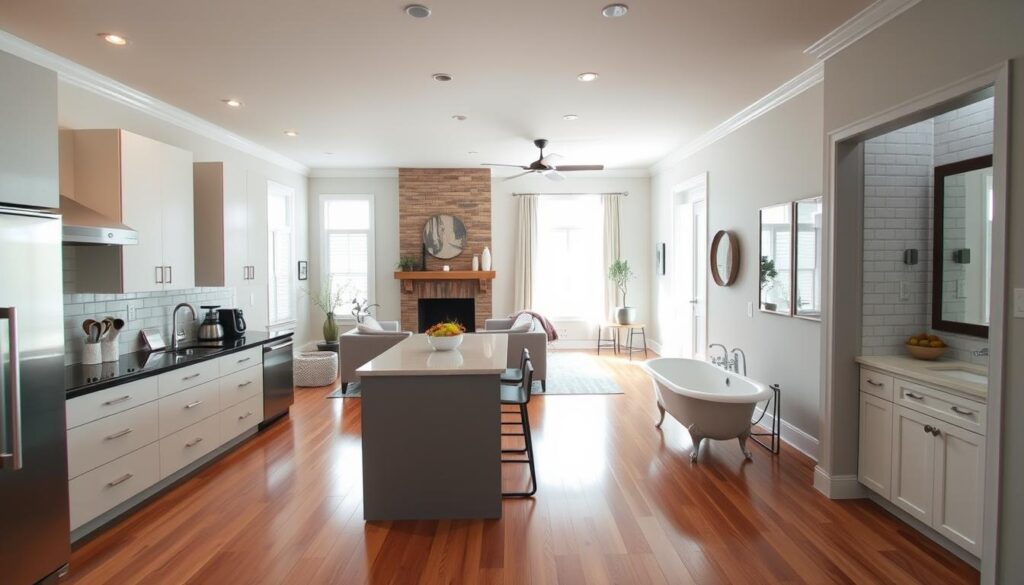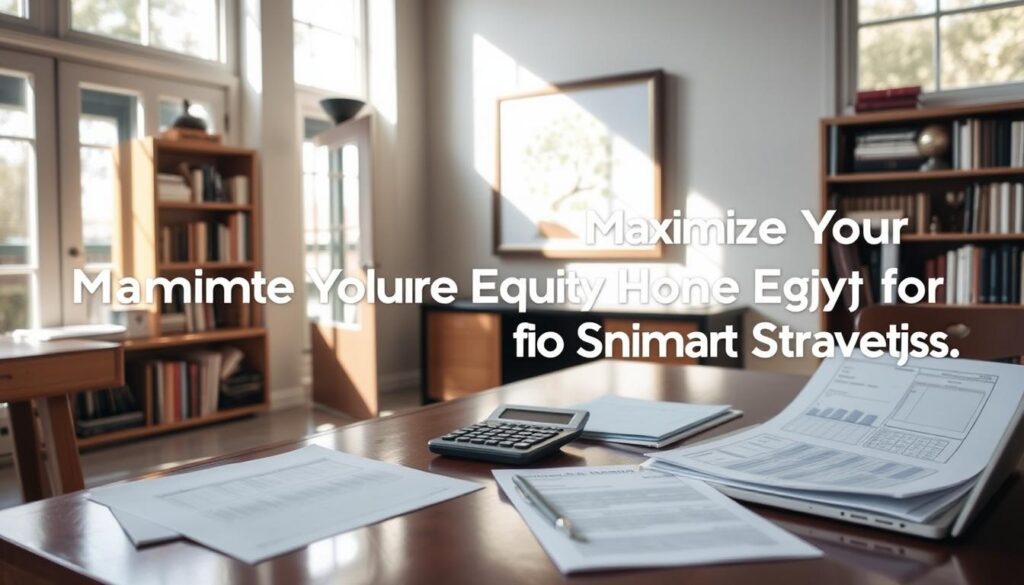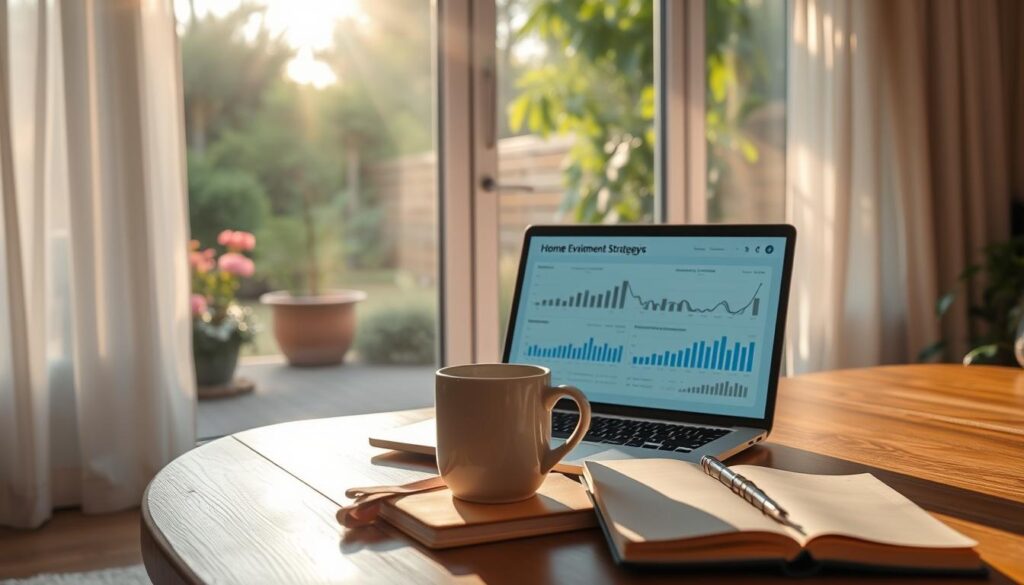Did you know that homeowners in the U.S. can recoup up to 70% of renovation costs through smart home investment strategies like modernizing kitchens or updating bathrooms? This statistic highlights how strategic choices can turn your house into a profitable asset.
Every year, millions of Americans invest in home improvements to boost equity, but many miss key opportunities. This guide breaks down proven methods to maximize returns, ensuring every dollar spent enhances both livability and market appeal.
Whether you’re planning to sell soon or stay long-term, understanding home investment strategies unlocks hidden potential. Learn how targeted upgrades—like energy-efficient windows or outdoor spaces—can add thousands to your property’s worth while improving daily comfort.
Discover how small, data-driven decisions can transform your home into a top-performing asset. Let’s start turning your living space into a smart investment, step by step.
Discover the True Potential of Your Home
Knowing your home’s worth is the first step in property value enhancement. Start by evaluating every aspect of your living space to uncover growth opportunities. Every detail—from the roof to the backyard—plays a role in boosting your investment’s potential.
Assessing Your Property’s Current Value
Three factors shape your home’s baseline value:
- Condition: Fix leaks, paint, or repair flooring to eliminate red flags
- Location perks: Proximity to parks, schools, or transit hubs
- Market data: Compare recent sales of similar homes in your area
According to Investopedia, even modest improvements can compound over time. Start by addressing repairs before moving to upgrades.
Recognizing Hidden Investment Opportunities
Look beyond the obvious. These overlooked areas can drive returns:
- Energy efficiency: Solar panels or upgraded insulation
- Unused spaces: Finished basements or outdoor living areas
- Smart technology: Voice-controlled systems or security upgrades
Small changes today can amplify your home’s appeal. Regular assessments ensure you stay ahead of trends driving property value enhancement. Prioritize upgrades that align with what buyers value most in your community.
Preparing for Strategic Home Investment
Before diving into renovations or upgrades, home equity utilization starts with clear preparation. Begin by defining your goals: Do you aim to boost resale value, attract renters, or create a space that enhances daily life? Every decision should align with your long-term vision.
- Research Market Trends: Study local housing data to identify what improvements buyers or renters prioritize in your area.
- Consult Professionals: Work with contractors and lenders to estimate project costs and potential returns.
- Calculate Equity Potential: Use online tools to assess how much equity you can leverage for projects.
| Renovation Type | Average Cost | Estimated ROI |
|---|---|---|
| Kitchen Upgrade | $25,000 | ~75% |
| Bathroom Remodel | $18,000 | ~70% |
| Hardwood Flooring | $10,000 | ~85% |
Use this table to compare options. Prioritize projects with high ROI while balancing your budget. Remember, home equity utilization isn’t just about spending—it’s about strategic choices that grow your property’s worth. Start with small, high-impact projects to test the market before scaling up. Always keep records of all costs and consultations to track progress and adjust plans as needed.
Budgeting and Financing Your Home Investment
Maximizing your home’s potential starts with smart financing home improvements. Home equity is your first resource—U.S. homeowners have gained $1.3 trillion in equity since mid-2023, with total equity now over $17.6 trillion. Understanding how to leverage this equity is key to funding projects without overextending financially.
Understanding Home Equity Fundamentals
Your home’s equity is the difference between its value and your remaining mortgage. Rising home values have boosted equity by 8% in the past year. This growth creates opportunities to tap into funds through loans or credit lines. For example, HELOC borrowing limits rose $9 billion over 10 quarters, offering flexible access to cash.
Exploring Financing Options
Compare options to choose the best fit for financing home improvements:
| Option | Costs | Interest Rates |
|---|---|---|
| HELOC | 2-5% of credit line (e.g., $2k–$5k for $100k limit) | Variable rates tied to prime rate |
| Cash-out refinance | 3-6% of loan amount | Fixed or adjustable rates |
| Personal loans | No upfront fees | Fixed rates (check Forbes for HELOC strategies) |
Crafting a Realistic Budget
Budget smartly by calculating total costs, including closing fees. HELOCs charge 2-5% of the line, while mortgages have 3-6% closing costs. Avoid high-interest debt like credit cards—Americans hold $1.17 trillion in such debt. Prioritize projects with proven ROI, like kitchen upgrades or energy-efficient systems.
Market Trends and Local Economic Insights
Staying informed about market trends analysis is key to making smart home investment choices. Local economic shifts and neighborhood changes directly affect your property’s future value. Start by tracking housing demand in your area—rising rents or job growth often signal strong potential.
- Track local job market stats: Strong employment in your area boosts demand for homes.
- Check school district rankings: Top-rated schools increase long-term property appeal.
- Review energy efficiency trends: Homes with solar panels or insulation upgrades often see higher ROI.
- Compare recent sales data: Use platforms like Realtor.com to gauge pricing trends.
Experts recommend using tools like Zillow’s Market Health Report or Redfin’s neighborhood guides to spot patterns. For instance, regions adopting green building standards may see faster appreciation. Regularly reviewing these trends helps you align renovations with what buyers want now—and in the future.
Local economic data also matters. Rising property taxes or zoning changes can alter your investment timeline. Stay ahead by attending city council meetings or signing up for local real estate newsletters. Combining this with market trends analysis ensures your decisions reflect both current conditions and upcoming opportunities.
How to Leverage Your Home’s Value Through Strategic Investment
Boosting your home’s value starts with clear strategies and smart investment risk management. This section breaks down actionable steps to turn your property into a profitable asset while minimizing potential downsides.
- Research Local Market Needs: Study what upgrades nearby buyers prioritize, like modern kitchens or energy-efficient systems.
- Prioritize High-ROI Projects: Focus on upgrades proven to increase resale value, such as bathroom renovations or smart home installations.
- Phase Projects: Break investments into manageable steps to avoid overspending. Start with exterior curb appeal before moving to interior changes.
Managing Investment Risks
Protect your investment with these key actions:
- Consult local contractors for cost estimates to avoid budget overruns.
- Review zoning laws to ensure planned upgrades comply with regulations.
- Set aside 10-20% of your budget for unexpected costs.
| Method | Risk Level | ROI Potential |
|---|---|---|
| Smart Home Technology | Moderate | High (long-term appeal) |
| Curb Appeal Upgrades | Low | Moderate (quick results) |
| Full Kitchen Remodels | High | High (if done strategically) |
Every choice should balance ambition with caution. By aligning upgrades with market trends and using tools like cost calculators from Remodeling Magazine’s Cost vs. Value Report, you can reduce uncertainty. Remember: small, informed steps today build a stronger foundation for future gains.
Renovation and Home Improvement as Investment Tools
Smart ROI home improvements can turn your house into a stronger asset. Start by targeting upgrades buyers prioritize. Kitchens and bathrooms lead in returns, with recent data showing bathroom remodels recouping up to 70% of costs. Energy-efficient upgrades like LED lighting or upgraded insulation also attract eco-conscious buyers while lowering bills.

Top Renovations for High Returns
- Kitchens: Modern countertops and appliances boost appeal
- Bathrooms: Updating fixtures and layouts add significant value
- Curb Appeal: Fresh paint and landscaping draw buyers immediately
Setting the Right Budget
Allocate funds wisely to maximize gains. Aim for projects under $20k for best returns. Prioritize visible upgrades like garage doors or entryways. Use contractor quotes to compare costs against resale value gains.
Track trends in your area to avoid overcustomizing. A real estate agent can highlight local preferences. Focus on timeless styles that appeal to most buyers rather than personal tastes. Every dollar spent should align with your long-term goals.
Maximizing Returns with Smart Property Upgrades
Investing in smart home technology can turn your property into a cutting-edge asset. Modern upgrades like automated lighting systems, voice-controlled appliances, and energy-efficient HVAC systems attract tech-savvy buyers and boost long-term value. These upgrades don’t just enhance daily life—they future-proof your investment against market shifts.
- Smart security systems (e.g., Ring cameras)
- Wireless thermostats (e.g., Nest Learning Thermostat)
- Automated irrigation systems
A study by the National Association of Realtors shows 67% of buyers prioritize homes with smart tech features. Here’s how key upgrades compare:
| Upgrade | ROI Potential | Key Benefits |
|---|---|---|
| Smart security systems | 90-100% recoup | Crime deterrence + remote monitoring |
| Energy-efficient windows | 85-95% recoup | Lower utility costs + noise reduction |
| Whole-home automation hubs | 80-85% recoup | Streamlined control of lighting/heating |
Pairing smart systems with eco-friendly materials maximizes appeal. For instance, adding solar panels alongside smart energy management software can cut bills by up to 30%. Prioritize user-friendly interfaces that simplify daily living while showcasing innovation. These choices position your home as a leader in modern living spaces.
Navigating Legal and Tax Considerations for Home Investment
Understanding legal tax considerations is essential to protect your home investment. Property taxes and compliance requirements vary by location, so staying informed helps avoid unexpected costs or legal issues.
Understanding Property Tax Implications
Property taxes can rise after major renovations. For example, adding a bathroom may increase your home’s assessed value, boosting your annual tax bill. Use online tools like PropertyShark or Zillow to estimate impacts before starting projects.
Consulting Legal and Tax Experts
Work with certified public accountants (CPAs) or real estate attorneys to review contracts and tax filings. They can identify deductions for renovation costs or mortgage interest. Key steps include:
- Reviewing tax forms like IRS Schedule D for capital gains
- Confirming zoning laws with local authorities
Ensuring Regulatory Compliance
Stay compliant by following these steps:
| Compliance Area | Action Steps |
|---|---|
| Zoning Regulations | Verify local building codes before starting projects |
| Tax Filing | Track deductible expenses for IRS submissions |
Legal tax considerations also involve checking state-specific rules. For instance, some states allow tax exemptions for energy-efficient upgrades. Consult your local assessor’s office for details.
Conclusion
Your home’s value grows when you apply the strategies outlined here. Start by evaluating your property’s current worth and explore strategic renovations like kitchen upgrades or energy-efficient systems. Platforms like Zillow and Redfin offer insights into local demand, while contractors on HomeAdvisor can help execute cost-effective projects. Remember to align choices with market trends and consult experts for tax and legal compliance. Begin with small, high-return updates—like bathroom remodels—and scale up as you gain confidence. Each step, from minor repairs to major strategic renovations, builds equity over time. Don’t delay—start planning today. Every decision you make now paves the way for stronger returns and a brighter financial future.



